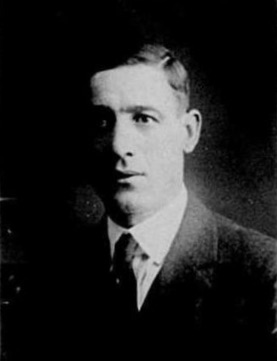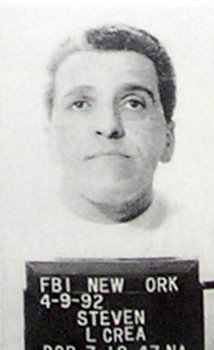
Carlo Gambino was a Sicilian-born American crime boss who was the leader and namesake of the Gambino crime family of New York City. Following the Apalachin Meeting in 1957, and the imprisonment of Vito Genovese in 1959, Gambino took over the Commission of the American Mafia and played a powerful role in organized crime until his death from a heart attack in 1976. During a criminal career that spanned over fifty years, Gambino served only twenty-two months in prison for a tax evasion charge in 1937.
The Gambino crime family is an Italian-American Mafia crime family and one of the "Five Families" that dominated organized crime activities in New York City, within the nationwide criminal phenomenon known as the American Mafia. The group, which went through five bosses between 1910 and 1957, is named after Carlo Gambino, boss of the family at the time of the McClellan hearings in 1963, when the structure of organized crime first gained public attention. The group's operations extend from New York and the eastern seaboard to California. Its illicit activities include labor and construction racketeering, gambling, loansharking, extortion, money laundering, prostitution, fraud, hijacking, and fencing.
The Havana Conference of 1946 was a historic meeting of United States Mafia and Cosa Nostra leaders in Havana, Cuba. Supposedly arranged by Charles "Lucky" Luciano, the conference was held to discuss important mob policies, rules, and business interests. The Havana Conference was attended by delegations representing crime families throughout the United States. The conference was held during the week of December 22, 1946, at the Hotel Nacional. The Havana Conference is considered to have been the most important mob summit since the Atlantic City Conference of 1929. Decisions made in Havana resonated throughout US crime families during the ensuing decades.
The Genovese crime family, also sometimes referred to as the Westside, is an Italian-American Mafia crime family and one of the "Five Families" that dominate organized crime activities in New York City and New Jersey as part of the American Mafia. They have generally maintained a varying degree of influence over many of the smaller mob families outside New York, including ties with the Philadelphia, Patriarca, and Buffalo crime families.
The Five Families refer to five Italian American Mafia crime families that operate in New York City. In 1931, the five families were organized by Charles "Lucky" Luciano following his victory in the Castellammarese War.

Thomas Gaetano Lucchese, sometimes known by the nicknames "Tommy", "Thomas Luckese", "Tommy Brown" or "Tommy Three-Finger Brown" was an Italian-American gangster and founding member of the Mafia in the United States, an offshoot of the Cosa Nostra in Sicily. From 1951 until 1967, he was the boss of the Lucchese crime family, one of the Five Families that dominate organized crime in New York City.

Thomas Gagliano was an Italian-born American mobster and boss of what U.S. federal authorities would later designate as the Lucchese crime family, one of the "Five Families" of New York City. He was a low-profile boss for over two decades. His successor was his longtime loyalist and underboss, Tommy Lucchese.

Steven L. "Stevie" Crea is an American mobster and former underboss of the Lucchese crime family. In August 2020, Crea was sentenced to life imprisonment for murder and racketeering.
The Commission is the governing body of the American Mafia, formed in 1931 by Charles "Lucky" Luciano following the Castellammarese War. The Commission replaced the title of capo di tutti i capi, held by Salvatore Maranzano before his murder, with a ruling committee that consists of the bosses of the Five Families of New York City, as well as the bosses of the Chicago Outfit and, at various times, the leaders of smaller families, such as Buffalo, Philadelphia, Detroit, and others. The purpose of the Commission was to oversee all Mafia activities in the United States and serve to mediate conflicts among families.

Gaetano Reina was an Italian-American gangster. He was an early American Mafia boss who was the founder of what has for many years been called the Lucchese crime family in New York City. He led the family until his murder on February 26, 1930, on the orders of Joe Masseria.
The French Connection was a scheme through which heroin was smuggled from Indochina through Turkey to France and then to the United States and Canada. The operation started in the 1930s, reached its peak in the 1960s, and was dismantled in the 1970s. It was responsible for providing the vast majority of the heroin used in the United States at the time. The operation was headed by Corsicans Antoine Guérini and Paul Carbone. It also involved Auguste Ricord, Paul Mondoloni and Salvatore Greco.
The 116th Street Crew, also known as the Uptown Crew, is a group of Italian-American mobsters within the Genovese crime family. In the early 1960s, Anthony Salerno became one of the most powerful capos in the family. Salerno based the crew in the Palma Boys Social Club located at 416 East 115th Street in East Harlem, Manhattan. By the late 1970s and early 1980s, the 116th Street Crew had absorbed and initiated many former members of the vicious East Harlem Purple Gang, an Italian-American murder for hire and drug trafficking gang operating in 1970s Italian Harlem and acting generally independent of the Mafia.
The Lucchese crime family is an Italian-American Mafia crime family and one of the "Five Families" that dominate organized crime activities in New York City, within the nationwide criminal phenomenon known as the American Mafia. Members refer to the organization as the Lucchese borgata; borgata is Mafia slang for criminal gang, which itself was derived from a Sicilian word meaning close-knit community. The members of other crime families sometimes refer to Lucchese family members as "Lukes".
The Bonanno crime family is an Italian-American Mafia crime family and one of the "Five Families" that dominate organized crime activities in New York City, and in the United States, as part of the criminal phenomenon known as the American Mafia.
The Tanglewood Boys was an Italian-American recruitment gang or "farm team" for the American Mafia, specifically the Lucchese crime family. The gang frequently operated from the Tanglewood Shopping Center in Yonkers, New York.
A Sixth Family is a crime family or criminal organization, usually an Italian-American or Italian-Canadian crime group, that has become powerful or notable enough to rise to a level comparable to that of the Five Families of the New York City Italian-American Mafia. A criminal organization deemed a "Sixth Family" may rival the Five Families or, alternatively, may work closely enough with the Five Families that it appears to be a peer or near coequal of the families.




